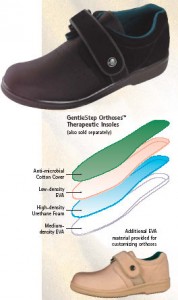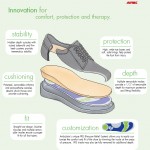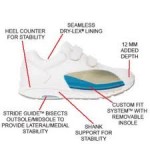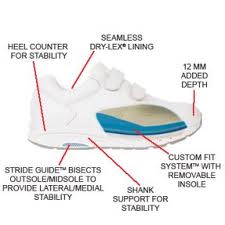Diabetic shoes, sometimes referred to as extra depth or therapeutic shoes, are specially designed shoes, or shoe inserts, intended to reduce the risk of skin breakdown in diabetics with co-existing foot disease.
 People with diabetic neuropathy in their feet may have a false sense of security as to how much at risk their feet actually are. An ulcer under the foot can develop in a couple of hours. The primary goal of therapeutic footwear is to prevent complications, which can include strain, ulcers, calluses, or even amputations for patients with diabetes and poor circulation. In addition to meeting strict guidelines, diabetic shoes must be prescribed by a physician and fit by a qualified individual, such as a certified pedorthist.
People with diabetic neuropathy in their feet may have a false sense of security as to how much at risk their feet actually are. An ulcer under the foot can develop in a couple of hours. The primary goal of therapeutic footwear is to prevent complications, which can include strain, ulcers, calluses, or even amputations for patients with diabetes and poor circulation. In addition to meeting strict guidelines, diabetic shoes must be prescribed by a physician and fit by a qualified individual, such as a certified pedorthist.
IT IS IMPORTANT TO SEE A PODIATRIST BEFORE GETTING ANY CUSTOM MOLDED ORTHOTIC.
A PODIATRIST CAN GENERALLY PERFORM A BIOMECHANICAL EXAM AND GAIT ANALYSIS AND PRESCRIBE A CUSTOM MOLDED FOOT ORTHOTIC. BY TAKING A CAST OF THE FOOT INÂ ITS OPTIMUM POSITION AND PRESCRIBING THE PROPPER ORTHOTICS NEEDED IS AN ATTEMPT TO TRY TO TREAT VARIOUS FOOT PROBLEMS. THERE ARE NO GUARANTEES. SOMETIMES ORTHOTICS CAN BE VERY BENEFICIAL WHEN PRESCRIBED AND CASTED BY A PODIATRIST.
The shoes must also be equipped with a removable orthotic. Foot orthotics are devices such as shoe inserts, arch supports, or shoe fillers such as lifts, wedges and heels. The diabetic shoes and custom-molded inserts work together as a preventative system to help diabetics avoid foot injuries and improve mobility.
Diabetic Work Shoes – Diabetic Dress Shoes and Diabetic Work Boots
 If you have diabetes, whether you work in an office or at a construction site, you’ll need a pair of reliable diabetic work shoes to get you through each day without risking diabetic foot injury. Made from breathable leather and suede materials, diabetic work shoes are designed to cushion while providing superior ankle, arch, and heel support, and evenly distributing body weight across the foot to avoid painful pressure points. Diabetic work shoes also provide the extra depth necessary to accommodate custom-orthotics which can mean the difference between end of the day foot pain and lasting comfort.
If you have diabetes, whether you work in an office or at a construction site, you’ll need a pair of reliable diabetic work shoes to get you through each day without risking diabetic foot injury. Made from breathable leather and suede materials, diabetic work shoes are designed to cushion while providing superior ankle, arch, and heel support, and evenly distributing body weight across the foot to avoid painful pressure points. Diabetic work shoes also provide the extra depth necessary to accommodate custom-orthotics which can mean the difference between end of the day foot pain and lasting comfort.
For a business casual environment, many men and women prefer to wear diabetic dress shoes. Diabetic dress shoes are usually more comfortable versions of popular fashion shoes such as women’s Mary Janes and men’s street loafers. HealthyFeetStore.com also sells steel-toed diabetic work boots, for outdoor workers looking for heavy-duty, performance diabetic foot protection.
Diabetic Walking Shoes
For people with diabetes walking can be especially beneficial to health. In addition to lowering cholesterol and decreasing the risk of cardiovascular disease, walking for diabetic exercise also lowers blood sugar level and improves circulation to the legs and feet. As a diabetic walker, you will need to pay careful attention to preventing foot problems such as blisters and calluses. Walk-related foot injuries tend to occur when a walker wears a shoe that is either the wrong type of shoe or a poor fit for their feet. Fortunately, most diabetic foot problems can be prevented by purchasing a pair of properly fitting diabetic walking shoes and paying proper attention to diabetic foot care.
Getting used to your shoes
People with decreased feeling in their feet may have a false sense of security as to how much at risk their feet actually are. An ulcer under the foot can develop in a couple of hours even if the shoes are expertly fit. In order to best avoid any irritation, please adhere to the following break-in schedule:
| FIRST DAY | Wear One Hour |
| SECOND DAY | Wear Two Hours – Check feet after first hour |
| THIRD DAY | Wear Three Hours |
| FOURTH DAY | Wear Four Hours – Check feet after two hours |
| FIFTH DAY | Wear Full Day – Check after lunch |
 IF AT ANY TIME YOU SEE RED SPOTS OR DARKNESS ON THE TOES OR OTHER BONY AREAS DURING THE FIRST FIVE DAYS: Discontinue wearing the shoes for the rest of the day and start routine again the next day beginning with one hour of wear.
IF AT ANY TIME YOU SEE RED SPOTS OR DARKNESS ON THE TOES OR OTHER BONY AREAS DURING THE FIRST FIVE DAYS: Discontinue wearing the shoes for the rest of the day and start routine again the next day beginning with one hour of wear.- IF A RED SPOT OR DARKNESS APPEARS WITH EVERY WEARING – DO NOT WEAR SHOES. Call our office for an adjustment appointment.
- BE SURE TO INSPECT YOUR FEET EVERY DAY.
Does Medicare Cover Diabetic Shoes?
Yes, Medicare will cover the cost of one pair of therapeutic shoes (diabetic shoes) and inserts for people with diabetes if you have a medical need for them. The Medicare payment for therapeutic shoes is subject to the requirement that they are necessary and reasonable for protection of insensitive feet or neuropathy (nerve damage in the feet).
